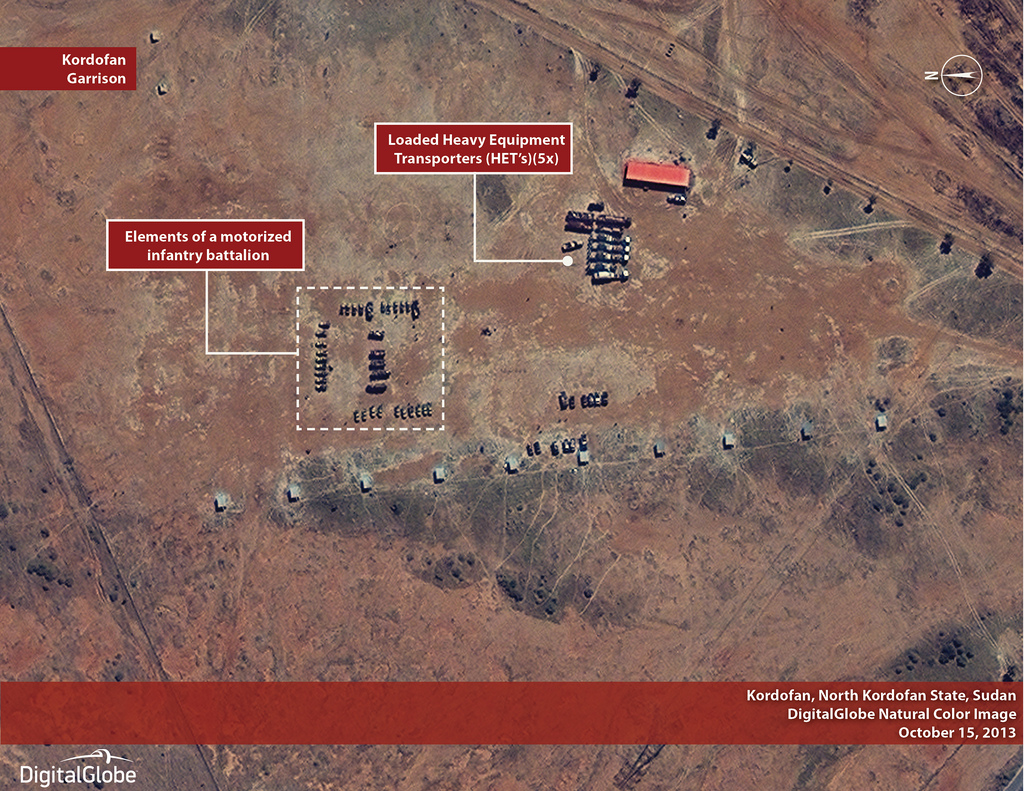
The Satellite Sentinel Project is issuing a human security warning for civilians living in Buram, Tess, and other areas to the south of Kadugli in Sudan’s South Kordofan state. Re-positioned aerial assets also place the highly contested Abyei area within range of the Sudanese army's arsenal. DigitalGlobe satellites will continue to monitor the Abyei area and watch for increased activity near Buram and Kadugli. We will issue additional alerts on signs of the Sudanese army's southbound movement.
The threat of renewed attacks on Sudanese civilians in South Kordofan, which could cause further displacement, is particularly worrying as food insecurity increases for hundreds of thousands of vulnerable people with the advent of the dry season. The people of South Kordofan have faced over two and a half years of aerial bombardment, and the deliberate destruction of homes and farmland, which amount to war crimes and crimes against humanity. Humanitarians have been denied access to help those in need. Those in Abyei have been displaced twice by Sudan Armed Forces, or SAF, attacks in the past five years: first in 2008 and then in 2011. Another offensive will deepen the humanitarian crisis in the region and poses a serious threat to human security.
Earlier Than Expected
DigitalGlobe imagery confirms increased troop movements and a significant buildup of ground and air materiel at several military installations. Following what many analysts describe as a deeply embarrassing rebel siege of Abu Kershola earlier this year, the Sudanese government has increased military spending, with the acquisition of new aircraft, including Fencer Su-24 from Belarus. To close its yawning budget gap, allow for these military expenditures and comply with the IMF's economic directives, the Sudanese government recently committed itself to removing subsidies on fuel and other commodities.
All of these indicators together point to a potential military campaign threatening vulnerable communities in the region. When considered along with the recent destruction of Buram Bridge in South Kordofan, this buildup suggests a possible new offensive, even before the rain waters subside. Since the strategic advantage from destroying the Buram bridge would be limited once the river dries, the Satellite Sentinel Project's analysts warn that an offensive might come earlier than expected. Increased aerial assets could also play a role in an offensive against the disputed Abyei region, where the Ngok Dinka community is planning a unilateral referendum.
The effects of the recent heavy rains are expected to last for at least another month, limiting mobility and clashes between the Sudanese army and the rebel Sudan People's Liberation Army-North, or SPLA-N. Military engagements between the SAF and the rebel SPLA-N, have traditionally slowed during the rainy season due to increased mobility constraints. However, the significant troop increases observed in October 2013 DigitalGlobe imagery, along with increased SAF military activity and bombardment around Um Shuran, Buram and Teith El Taice, or Tess, all south of Kadugli, signal a possible resurgence in activity, even before the rain waters fully recede. Following the Abena protests at the end of September 2013, the SPLA-N rebels ended their month-long unilateral ceasefire and announced that they would be returning to the battlefield to "enhance" the prospects of the peaceful uprising in Sudan's northern cities. Already Médecins Sans Frontières has reported that at least 2,500 Sudanese fled their homes due to fighting in the Warni and Kau-Nyaro areas in the southeast of South Kordofan. These new refugees have arrived in the towns of Kodok and Lelo, in South Sudan’s Upper Nile State. Evidence of the Sudanese army's recent buildup suggests that more civilians might be at risk.
Read or download the full report.
View the satellite imagery on Flickr.
Correction: An earlier version of this report attributed aircraft participating in a UNISFA troop rotation at Kadugli Air Base to the Sudan Armed Forces. Since the signature visual identifiers of SAF helicopters match those of United Nations aircraft, imagery analysts find it difficult to distinguish between the two.
Photo: A probable Motorized Infantry Battalion (MIB) in South Kordofan (DigitalGlobe)

